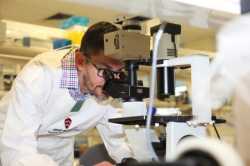Author Interviews, Biomarkers, Pancreatic / 17.08.2015
Urine Biomarker Panel Detects Early Pancreatic Cancer
 MedicalResearch.com Interview with:
Tatjana Crnogorac-Jurcevic MD PhD
Reader Centre for Molecular Oncology
Barts Cancer Institute, Queen Mary
University of London
London UK
Medical Research: What is the background for this study? What are the main findings?
Dr. Crnogorac-Jurcevic: Pancreatic adenocarcinoma (PDAC) is one of the most difficult cancers to detect. More than 80% of patients usually present at a late stage, with either locally advanced or with already metastatic disease. This is one of the major reasons for a bleak prognosis of this malignancy, which is typically 3-6 months and with <5% five-year survival. However, if patients are diagnosed with stage II disease, the survival rate is 20%, and at stage I, in patients with very small tumours, the five-year survival can increase up to 60%.
In order to find biomarkers for early detection of this disease, we have performed in depth GeLC/MS/MS (SDS-PAGE-liquid chromatography-tandem mass spectrometry) analysis of 18 proteomes of urine samples collected from healthy controls, chronic pancreatitis, and patients with Pancreatic adenocarcinoma and obtained around 1500 non-redundant proteins. From these, three proteins, LYVE-1, REG1A, and TFF1, were selected for further analysis based on their known biological functions and statistical difference in comparisons of the experimental groups. These biomarkers were subsequently validated using ELISA assays in a multicenter cohort of urine samples: 87 from healthy people, 92 from patients with chronic pancreatitis, and 192 from PDAC patients.
Multiple logistic regression was then applied: when comparing Pancreatic adenocarcinoma with healthy urine specimens, the resulting areas under the receiver-operating characteristic curves (AUC) of the three biomarkers combined into a panel were 0.89 (95% confidence interval: 0.84–0.94) in the training dataset (70% of the data) and 0.92 (95% confidence interval: 0.86–0.98) in the validation dataset (30% of the data). When the results from the analysis of PDAC stage I–II (n=71) urine samples were compared with the healthy urine specimens, the panel achieved AUCs of 0.90 (95% confidence interval: 0.84–0.96) and 0.93 (95% confidence interval: 0.84–1.00) in the training and validation datasets, respectively. In comparison to matching plasma CA19.9 values, the only Pancreatic adenocarcinoma biomarker in widespread clinical use (albeit mostly for monitoring of the disease), the panel achieved a higher AUC of 0.97 (95% confidence interval: 0.94–0.99) than CA19.9 (AUC 1/4 0.88; 95% confidence interval: 0.81–0.95, P=0.005). When combined with CA19.9, increased AUC of 0.99 (95% confidence interval: 0.97–1.00, P=0.04) was achieved, but this was not seen in a panel combined with plasma CA19.9 in stage I–IIA PDAC (n =17) vs. healthy sample comparison.
(more…)
MedicalResearch.com Interview with:
Tatjana Crnogorac-Jurcevic MD PhD
Reader Centre for Molecular Oncology
Barts Cancer Institute, Queen Mary
University of London
London UK
Medical Research: What is the background for this study? What are the main findings?
Dr. Crnogorac-Jurcevic: Pancreatic adenocarcinoma (PDAC) is one of the most difficult cancers to detect. More than 80% of patients usually present at a late stage, with either locally advanced or with already metastatic disease. This is one of the major reasons for a bleak prognosis of this malignancy, which is typically 3-6 months and with <5% five-year survival. However, if patients are diagnosed with stage II disease, the survival rate is 20%, and at stage I, in patients with very small tumours, the five-year survival can increase up to 60%.
In order to find biomarkers for early detection of this disease, we have performed in depth GeLC/MS/MS (SDS-PAGE-liquid chromatography-tandem mass spectrometry) analysis of 18 proteomes of urine samples collected from healthy controls, chronic pancreatitis, and patients with Pancreatic adenocarcinoma and obtained around 1500 non-redundant proteins. From these, three proteins, LYVE-1, REG1A, and TFF1, were selected for further analysis based on their known biological functions and statistical difference in comparisons of the experimental groups. These biomarkers were subsequently validated using ELISA assays in a multicenter cohort of urine samples: 87 from healthy people, 92 from patients with chronic pancreatitis, and 192 from PDAC patients.
Multiple logistic regression was then applied: when comparing Pancreatic adenocarcinoma with healthy urine specimens, the resulting areas under the receiver-operating characteristic curves (AUC) of the three biomarkers combined into a panel were 0.89 (95% confidence interval: 0.84–0.94) in the training dataset (70% of the data) and 0.92 (95% confidence interval: 0.86–0.98) in the validation dataset (30% of the data). When the results from the analysis of PDAC stage I–II (n=71) urine samples were compared with the healthy urine specimens, the panel achieved AUCs of 0.90 (95% confidence interval: 0.84–0.96) and 0.93 (95% confidence interval: 0.84–1.00) in the training and validation datasets, respectively. In comparison to matching plasma CA19.9 values, the only Pancreatic adenocarcinoma biomarker in widespread clinical use (albeit mostly for monitoring of the disease), the panel achieved a higher AUC of 0.97 (95% confidence interval: 0.94–0.99) than CA19.9 (AUC 1/4 0.88; 95% confidence interval: 0.81–0.95, P=0.005). When combined with CA19.9, increased AUC of 0.99 (95% confidence interval: 0.97–1.00, P=0.04) was achieved, but this was not seen in a panel combined with plasma CA19.9 in stage I–IIA PDAC (n =17) vs. healthy sample comparison.
(more…)























